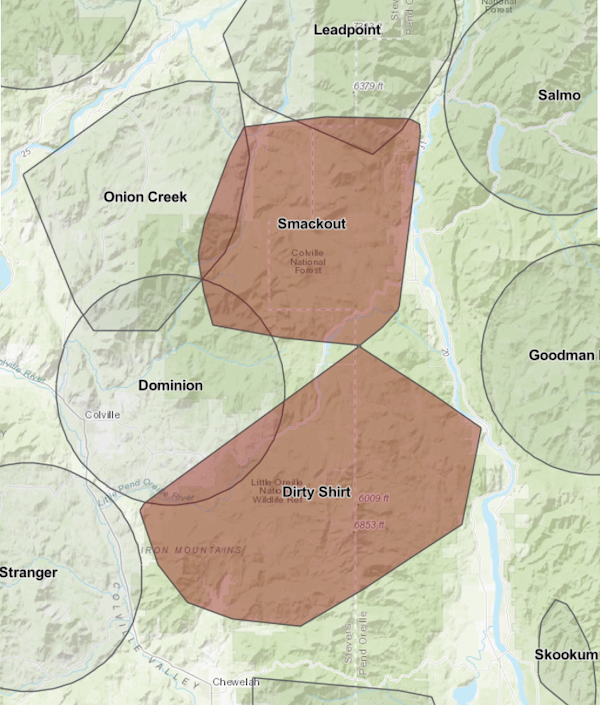
2 Wolves Lethally Removed In NE WA After Cattle Depredations
WDFW reports state biologists killed a pair of adult wolves in the Leadpoint Pack territory of northern Stevens County earlier this week in response to a series of calf depredations on private lands in late summer.
“With the removal of two wolves, the lethal removal authorization and lethal removal permit are now expired,” agency wolf managers stated this morning.
They will look at it as continuing to carry out their management responsibilities around a species that has been federally delisted in this ranch-speckled part of the state, but it also provides an answer as to whether WDFW would again go lethal so soon after an incident earlier this month that sparked controversy on both sides of the wolf world.

In this latest case, last week Director Kelly Susewind greenlighted removing up to two wolves from the Leadpoint Pack, which have been blamed for killing two calves and a cow and injuring two calves in a series of attacks that began in August. Protocols call for considering removal after three depredations in 30 days or four in 10 months, if conflict-prevention actions have been taken.
According to WDFW, the rancher whose cattle were being depredated on had used “more than two” proactive and responsive measures to try and head off wolf attacks. The producer had also decided against grazing on a Forest Service allotment where attacks occurred last year.
The removal permits went to both WDFW biologists and the cattle owner, but WDFW said it had removed both – an adult male wolf on Tuesday and an adult female on Wednesday.
“Neither were the breeders in the pack. They were both 2 years old or younger,” stated spokeswoman Staci Lehman in Spokane, adding wolves that young typically don’t breed.
The removals are WDFW’s second and third this month.
In the earlier case, in response to calf depredations elsewhere in Northeast Washington, Susewind had OKed “the lethal removal of one wolf from the Smackout pack territory,” and on September 8 WDFW killed what turned out to be a pup in an area used by the Smackout Pack, as well as the neighboring Dirty Shirt wolves.
That sparked negative comments on both sides of the wolf world, with wolf advocates glomming onto a Spokesman-Review headline that termed the removal a mistake, using it to further an agenda of questioning WDFW management of the species.
And in one The Center Square piece, Scott Nielsen, the head of a local cattlemen’s association, said it didn’t do much good to kill a wolf from a neighboring pack that isn’t depredating, and in a follow-up article as Leadpoint depredations added up, he wondered if it hadn’t been a case of “sabotage” by WDFW: “There is a lot of political motivation to not address this problem so we need to question what is happening here.”
A local wildlife deputy also told The Center Square there weren’t any black-coated wolves in Smackout but there are in Dirty Shirt, and that the pup had been “chased and killed in Dirty Shirt territory.”

DNA testing could likely immediately resolve which pack the pup actually came from, but samples are only submitted once a year, according to WDFW wolf policy lead Julia Smith.
She acknowledged WDFW’s intention had not been to take a pup, but without another wolf nearby for reference, it can be hard to tell size very easily.
“This is just as upsetting for us as it is for the communities involved,” Smith said. “It’s really difficult work and we all want to succeed to minimize removals and depredations.”
In response to that second Center Square story, I asked WDFW’s Lehman a series of questions around the color of Smackout and Dirty Shirt wolf coats and where exactly the pup had been shot, and she provided some more background.
“During summer, if a wolf pack is experiencing livestock conflicts, WDFW does attempt to count pack numbers and document approximate age class and coloration patterns. However, just like with our annual winter counts, even with a series of trail cameras and tracking individuals, it is only possible to ever collect a MINIMUM count – not all wolves are present in a pack (or on camera) all the time, especially in the summer when packs are less cohesive and pack members travel separately more often than in winter,” she stated.
“Staff had knowledge of gray wolves in the Smackout Pack and gray and black wolves in the Dirty Shirt Pack – knowing colors present does not mean there are not additional wolves in the pack unaccounted for, because again, a MINIMUM count is all that can actually be obtained. The juvenile wolf was killed within the area that the Smackout Pack utilizes, but it was on the periphery where the Dirty Shirt Pack also ranges from time to time. The juvenile was in close proximity to a collared wolf from the Smackout pack when it was killed,” Lehman noted.
What’s been surprising for me in all of this is how squishy wolf territories apparently can be. From everything I’ve read and been told about how hyperterritorial they are, I’d assumed that pack borders were pretty set in stone and crossing that invisible line was tantamount to a death sentence. Smith says they can overlap, and that packs may also try to usurp other wolves’ ranges. I doubt a pup could make much headway against a pack.
As for the Leadpoint wolves, there was a minimum of 10 in the pack as of the end of last year, and Lehman reports that prior to this week’s removals there was a minimum of 12 – six known adults and six known pups.
WDFW uses lethal removals to try and head off a pack’s bad behavior and reduce the number of mouths to feed in it. Such operations are unlikely to impede the recolonization and recovery of wolves across Washington.

